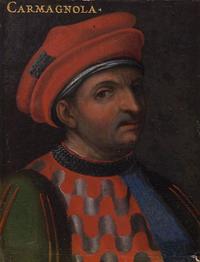
Italian condottieri. Named for his place of birth near Turin, he entered military service at age 12 with a company of condottieri hired by Milan. When he was just 30 he took command of an army of mercenaries and led them to quick success in a Milanese civil war over the ducal succession. In 1422 he commanded a large Milanese and mercenary army against the Swiss at Arbedo, where his order to deny any quarter so stiffened Swiss resistance that a much smaller force hacked its way through his men and escaped.
Battle of (Arbedo, 1422).
Several Swiss cantons wished to expand into northern Italy. The Milanese contracted the condottieri captain Carmagnola to defend them with an army of 16,000 mercenaries, including 5,000 cavalry. The Swiss fielded a force of just 2,500. Carmagnola surprised these men in camp. The Swiss quickly formed a pike square and held back repeated attacks by the enemy horse, until Carmagnola ordered men-at-arms to attack dismounted. Sheer weight of numbers forced the Swiss into a fighting retreat along a steep defile, in which they became trapped. When Carmagnola ordered no quarter the Swiss ranks stiffened and steadied. Swinging halberds wildly, the men of the Cantons cut their way right through the Italian foot and escaped the trap, although they left many hundreds of dead behind. Shortly after the battle a Diet was held in Lucerne that decided to add more pikes to the Swiss square to better protect halberdiers and archers. This reform led to the maturation of Swiss formations and tactics, so that they became the supreme infantry of the 15th century in Europe.
Fear of his ability and ambition on the part of his Milanese employer led to an offer of a strictly civilian post in 1525, as governor of Genoa. More interested in the lucrative life of a mercenary playing all sides against the middle, Carmagnola offered his services to Venice, which he then persuaded to attack Milan. He was appointed Captain-General of St. Mark (1526) and led Venetian forces in a costly, but inconclusive, war with Milan which he did much to deliberately prolong. All the time, he secretly negotiated a possible return to Milanese service. The Council of Ten learned of this treachery and brought him to trial. Upon conviction, he was beheaded.